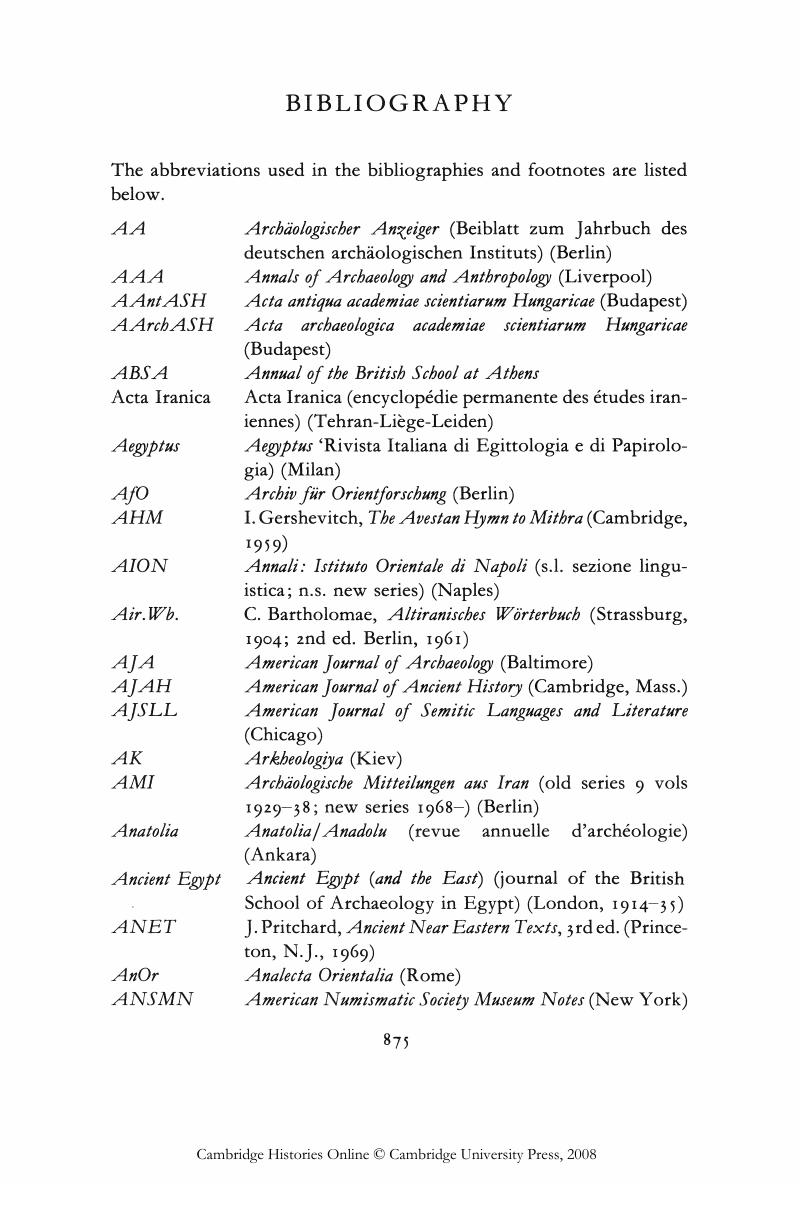Book contents
- Frontmatter
- 1 ELAM
- 2 ANSHAN IN THE ELAMITE AND ACHAEMENIAN PERIODS
- 3 MEDIA
- 4 THE SCYTHS
- 5 THE RISE OF THE ACHAEMENIDS AND ESTABLISHMENT OF THEIR EMPIRE
- 6 PERSIA AND THE GREEKS
- 7 CYRUS THE GREAT (558–529 b.c.)
- 8 ALEXANDER IN IRAN
- 9 THE PERSIAN OCCUPATION OF EGYPT
- 10 THE BABYLONIAN EVIDENCE OF ACHAEMENIAN RULE IN MESOPOTAMIA
- 11 THE EVIDENCE OF THE PERSEPOLIS TABLETS
- 12 ACHAEMENID COINS, WEIGHTS AND MEASURES
- 13 THE OLD EASTERN IRANIAN WORLD VIEW ACCORDING TO THE AVESTA
- 14 THE RELIGION OF ACHAEMENIAN IRAN
- 15 ARAMAIC IN THE ACHAEMENIAN EMPIRE
- 16 OLD IRANIAN CALENDARS
- 17 CLASSIC ACHAEMENIAN ARCHITECTURE AND SCULPTURE
- 18 THE BEHISTUN RELIEF
- 19 TEPE NŪSH-I JĀN: THE MEDIAN SETTLEMENT
- 20 PASARGADAE
- 21 METALWORK AND GLYPTIC
- Appendix I PLANT NAMES
- Appendix II THE ACHAEMENID DYNASTY
- Bibliography
- Index
- Plate section
- Plate section
- Plate section
- Media in the 9th–7th centuries b.c
- The Achaemenian empire.
- The Aegean basin, to illustrate the Greek wars of Darius and Xerxes.
- Media in the 9th–7th centuries b.c">
- References
- Frontmatter
- 1 ELAM
- 2 ANSHAN IN THE ELAMITE AND ACHAEMENIAN PERIODS
- 3 MEDIA
- 4 THE SCYTHS
- 5 THE RISE OF THE ACHAEMENIDS AND ESTABLISHMENT OF THEIR EMPIRE
- 6 PERSIA AND THE GREEKS
- 7 CYRUS THE GREAT (558–529 b.c.)
- 8 ALEXANDER IN IRAN
- 9 THE PERSIAN OCCUPATION OF EGYPT
- 10 THE BABYLONIAN EVIDENCE OF ACHAEMENIAN RULE IN MESOPOTAMIA
- 11 THE EVIDENCE OF THE PERSEPOLIS TABLETS
- 12 ACHAEMENID COINS, WEIGHTS AND MEASURES
- 13 THE OLD EASTERN IRANIAN WORLD VIEW ACCORDING TO THE AVESTA
- 14 THE RELIGION OF ACHAEMENIAN IRAN
- 15 ARAMAIC IN THE ACHAEMENIAN EMPIRE
- 16 OLD IRANIAN CALENDARS
- 17 CLASSIC ACHAEMENIAN ARCHITECTURE AND SCULPTURE
- 18 THE BEHISTUN RELIEF
- 19 TEPE NŪSH-I JĀN: THE MEDIAN SETTLEMENT
- 20 PASARGADAE
- 21 METALWORK AND GLYPTIC
- Appendix I PLANT NAMES
- Appendix II THE ACHAEMENID DYNASTY
- Bibliography
- Index
- Plate section
- Plate section
- Plate section
- Media in the 9th–7th centuries b.c
- The Achaemenian empire.
- The Aegean basin, to illustrate the Greek wars of Darius and Xerxes.
- Media in the 9th–7th centuries b.c">
- References
Summary

- Type
- Chapter
- Information
- The Cambridge History of Iran , pp. 875 - 930Publisher: Cambridge University PressPrint publication year: 1985

